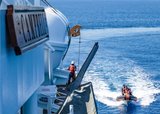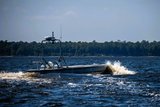Raytheon awarded $84.7 million for ALR-67(V)3 contract
Raytheon has received an $84.7 million US Navy contract for continued production of ALR-67(V)3 digital radar warning receivers. The contract was awarded by the U.S. Naval Air Systems Command, Patuxent River, Md.
The ALR-67(V)3 is the US Navy standard for digital radar warning receiver technology. It is made for installation on all frontline, carrier-based F/A-18 E/F tactical aircraft and is an integral part of modernization programs for U.S. and international customers.
The ALR-67(V)3 is the first deployed radar warning receiver to combine fully channelized digital receiver architecture with the power of dual processors. Its innovative architecture enables the successful detection of emitters in high-density electromagnetic environments and uses leading-edge digital technology for improved reliability.
"This technology is fully integrated with all avionics equipment on the Super Hornet. Warfighters need its advanced functionality to support increasingly complex combat operations," said Scott Jackson, general manager of Raytheon's electronic warfare systems product line. "The ALR-67(V)3 improves aircrew survivability by providing immediate and accurate situational awareness of the threat environment."
Deliveries are expected to begin January 2013 with production scheduled at Raytheon facilities in Forest, Miss. and McKinney, Texas.
Source: Raytheon
More from Digital Battlespace
-
![Babcock nears first customer for Nomad AI translation tool]()
Babcock nears first customer for Nomad AI translation tool
Nomad can provide militaries with real-time intelligence, saving critical time on the battlefield.
-
![AUSA 2025: Israel’s Asio Technologies to supply hundreds of improved Taurus tactical systems]()
AUSA 2025: Israel’s Asio Technologies to supply hundreds of improved Taurus tactical systems
Taurus operates alongside the Israel Defense Forces’ Orion system which supports mission management across tens of thousands of manoeuvring forces, from squad leaders to battalion commanders.
-
![AUSA 2025: Kopin pushes micro-LED plans as China moves faster]()
AUSA 2025: Kopin pushes micro-LED plans as China moves faster
The plan for the new displays follows fresh investment in Kopin’s European facilities by Theon and an order for head-up displays in fielded aircraft, with funding from the US Department of Defense.
-
![AUSA 2025: Persistent Systems to complete its largest order by year’s end]()
AUSA 2025: Persistent Systems to complete its largest order by year’s end
Persistent Systems received its largest ever single order for its MPU5 devices and other systems earlier this month and has already delivered the 50 units to the US Army’s 4th Infantry Division.
-
![Aselsan brings in dozens of companies and systems under the Steel Dome umbrella]()
Aselsan brings in dozens of companies and systems under the Steel Dome umbrella
Turkey has joined the family of countries attempting to establish a multilayered air defence system with government approval in August 2024 for the effort landed by Aselsan. Dubbed Steel Dome, the programme joins Israel’s Iron Dome, the US Golden Dome, India’s Mission Sudarshan Chakra and South Korea’s low-altitude missile defence system.
-
![DSEI 2025: MARSS unveils new agnostic multidomain C4 system]()
DSEI 2025: MARSS unveils new agnostic multidomain C4 system
MARSS’ NiDAR system has been deployed using sensors from static platforms to provide detection and protection for static sights, such as critical infrastructure, ports and military bases.


























